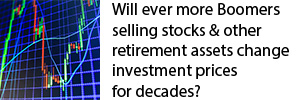A Financial "Perfect Storm" May Be Brewing
by Daniel R. Amerman, CFA
The "Perfect Storm" of 1991, as described in the best-selling book by Sebastian Junger, resulted from massive weather systems converging to create the storm of a century.
In the financial world at this very moment, we have eight different "weather systems" that are all developing in real time. While the defenses in place may be able to easily withstand any one or two of these concerns in isolation – the danger is the increased power of a "storm" that can result from the merging of multiple systems together.
Using a weather analogy is appropriate, because there is little predictability at this point, everything is still developing (the "storm fronts" are still building), and while some of the factors are long term, others have just been emerging in the last few days and weeks. However, if several of the more powerful components were to converge – and reinforce each other – then we could very rapidly reach the point of greatest financial instability that the world has seen since 2008.
In the following sections we will assemble a step by step description of each of these eight "weather systems" and how they interrelate.
1) Very Low Interest Rates
Because of the openly stated policy of central banks such as the Federal Reserve and the European Central Bank, we currently have very low interest rates around the world.
2) Artificially Elevated Asset Prices
As explored in my recent article, "Mazes, Mice And Investor Perception Management" (link here), one of the several intentions behind forcing these very low interest rates has been to drive asset prices upwards, thereby creating artificially high market prices in the hopes of generating a "wealth effect" that is intended to change investor behavior and stimulate the economy. The economic stimulation has not occurred, but a fundamental mismatch has been created around the globe between overpriced bonds and equities, and what can be justified by the underlying fundamentals.
3) Developing Fears Of A Liquidity Crunch
As stated in a recent speech by Steven Maijoor, chairman of the European Securities and Markets Authority (ESMA), global central banking actions including quantitative easing and other forms of unconventional monetary policy have created the risk of a liquidity crunch. The central banks have created risks of "over-valuation" in the bond and equity markets that are "considerable", and are "raising risks for the non-banking sector".
And when liquidity is an issue, a shift in investor sentiment that could otherwise be easily contained in a large and healthy market can instead set off a stampede for the exits, which can dramatically change markets overnight – possibly in a matter of minutes or hours.
The relationship between the two financial "weather systems" is that the same central banking action – that of creating massive sums of money to buy government bonds – also creates two separate but tightly intertwined risks that can feed off each other. One is major market overvaluation, which creates the risk of a sharp drop to levels that can be rationally justified, and the other is a reduced supply of bonds, which exacerbates the chances of any correction of prices occurring in a disorderly manner that could create a market collapse.
4) A Current Global Bond "Rout"
First, we need to keep in mind that despite its recent frequent usage by the mainstream financial media - the term "rout" is a relative one. Yes, we have over the last ten days or so seen some of the largest and most rapid price shifts in global bond markets in some years, and when we compare this to the artificial placidity of government and central bank-dominated bond markets of the recent past, this is a remarkable rout. From a longer term historical perspective we're still not there yet – but a global sell-off is in process, and this combination of circumstances could yet get us to the real thing.
5) The Dangerous Combination Of Falling Bond Prices & Bond ETFs
Much of the financial markets have transformed since 2008, and while the emphasis by regulators has been on "fighting the last war" by attempting to reduce bank risks, in many ways total risk is higher than ever – but it's just been transferred to other places.
As covered in this Reuters article, this transfer of risk can be seen right now with the measures by Vanguard, Guggenheim Investments, and First Trust, as some of the largest bond exchange traded funds (ETFs) in the US scramble to secure lines of credit.
The fear is that if the bond rout continues to develop, and large numbers of investors start redeeming their ETFs, then these massive companies must immediately sell their bond portfolios into a thin and plunging market – thereby exacerbating liquidity risk.
So these firms are scrambling to pay for lines of credit from major banks that will allow them to meet redemptions without flooding the market with bonds – but this also brings two concerns. One is the price of the line of credit, and the other is that in a true crisis situation – will the banks be able to make good on their promises? That is, will the money be there to fund the line of credit if the banks are facing liquidity crises of their own?
This risk directly feeds into and exacerbates the previous two risks. Absent sufficient lines of credit, ETF redemptions translate to forced sales, regardless of market prices. If markets correct to more rational levels, and investors in large numbers head for the exits to get out of bonds, and this leads to massive quantities of forced sales to get the money to make the redemptions, and this happens in a thin market where buyers have evaporated – then we have a near perfect recipe for a financial storm of extraordinary magnitude, and which could develop with blinding speed.
6) A Potential Sea Change In Institutional Investor Perceptions And Behavior
One of the key underpinnings of market stability in recent years has been an effective "retraining" of institutional investors. What these investors have been taught over recent years has been more or less to ignore market fundamentals, and instead follow the leads of the central banks. Because acting on economic fundamentals rather than following the leads of central banks has been a very poor career decision for some years now, with markets that have moved with central banking actions.
And this is why so many otherwise highly intelligent and trained financial professionals have been buying bonds and stocks at what might seem to be irrational levels – for they effectively have had no choice.
What is happening with this developing global bond "rout" (again keeping in mind this is a relative term) is that we are seeing investors moving against the central banks in large numbers for the first time in years. Which shows a very real fear on their part that the central banks could lose control of their artificial stability.
This is a particularly serious danger because it can be a self fulfilling prophecy, where compliant and trained investors who were the source of much of the previous stability are now behaving more independently. This danger of 1) a major source of stability not only being lost but being flipped into 2) a major source of instability can acutely exacerbate financial stability risk – particularly in the environment with the other risks previously described.
7) Heightened Risks From Currency Warfare
Also of particular concern is a truth which former Bank of England head Mervyn King can candidly speak about now that he is out of office, which is that quantitative easing can become currency warfare, and indeed, there is a case that a de facto currency war already exists (Bloomberg article link). That is, nations are seeking competitive advantage for their own economies by creating large sums of money in order to make their currency cheaper than other countries, meaning their exports increase and their imports decrease. The issue is that because this competition is an inherently unstable and dangerous process, currency wars can spin out of control, and quite quickly.
Of crucial importance is that there is direct connection between currency warfare and the other "systems". Quantitative easing typically involves creating money to buy government bonds and other securities, and it is done on a large scale. This pushes prices further upward – increasing the magnitude of a market correction. Meanwhile these same actions simultaneously reduce the supply of assets available to private investors – increasing liquidity crunch risk. So nations seeking to competitively devalue their currencies directly feed energy into the other "weather systems".
Again, the "perfect storm" analogy seems to be an apt one. Deliberately pushing stock and bond prices higher than they should be creates markets that are inherently unstable. Liquidity crunches are destabilizing and dangerous. Currency warfare is destabilizing and dangerous. But what is far worse is when those three destabilizing "weather systems" not only merge together but also feed "energy" to each other and as a result they triple (or more) in strength.
8) The Greek"Trigger"
While the 1991 "perfect storm" was the convergence of multiple weather systems, it is the eighth financial "weather system" of 2015 that truly brings things into dangerous territory in the near term. This eighth source of destructive financial energy is the profoundly destabilizing event of a potential Greek default, and the related but not identical risk of a Greek exit from the eurozone.
The political change in Greece has created a sharp new risk for the euro and the world, as discussed in my articles here and here. If it is a Greek crisis by itself – the general consensus thus far has been that the system could quite likely handle the stress.
But what needs to be understood is that this consensus was based on the relatively more stable system that existed as of a month ago or three months ago. Under that previous set of circumstances, we could liken Greece to a potential "Category One" hurricane blowing around in isolation off the Atlantic coast, where even if it did eventually make landfall, it wouldn't necessarily be a world changer at all. The damage would instead likely be fairly limited and quite containable.
The problem is if a Category One Greek hurricane runs into a liquidity crunch, at the same time that the ETF structure is being stressed globally, at the same time that investors are experiencing genuine fear and heading for the exits, and at the same time that we have currency warfare in effect on a global basis – this could set off a scenario that rivals or surpasses the financial crisis of 2008, and it could happen very, very quickly indeed.
It's also important to understand that while many view Greece to be a European problem, these "weather systems" are global in nature. That is, if Greece does "trigger" a financial crisis – that crisis won't necessarily initially manifest in Europe, and it may not happen instantly. As one possible scenario, a Greek default pushes the euro down sharply. As a defensive currency warfare measure, other nations enter into or increase their degree of quantitative easing – such as the United States, or Japan, or Australia or Canada. This then feeds the "energy", in the form of still higher asset prices and still lower liquidity. This increased instability could then quickly set off by a further deterioration in Europe, or it could be set off by something else altogether, months or years later, in an entirely different part of the world.
A Radar Map That Is "Lighting Up"
Per the International Monetary Fund, and as explored in this article (link here), modern severe financial crises can stem from the intersection of three separate but deeply intertwined risks – those of contagion risk, liquidity risk and counterparty risk.
And this "perfect storm" that is developing is starting to look like it could potentially trigger all three of these risks.
Now, does this mean a certain end of the financial world as we know it?
No.
To keep with the weather analogy, what it means is that we seem to be at that place where "high energy systems" and fronts have been popping up all over the place, and really getting those meteorologists on the Weather Channel all worked up. They can't give us a forecast with certainty, the models are conflicting, they don't know the exact storm tracks, and they don't know all the details about what is strengthening or weakening.
But what they do know is that a previously relatively boring radar map has been replaced by surging energy and a multiplying array of new systems. They know that a rapidly evolving situation has come into existence where an event of historic magnitude is entirely possible, and it can happen with great speed.
In other words, this analysis isn't a forecast or a "call", but rather a "head's up" that our radar map is starting to light up from one end to the other with notable developments.
Another consideration is what I covered in my most recent article (link here), where I discuss the almost total disconnect between what the general public thinks is going on with the markets, and what many highly knowledgeable insiders are aware of. And this developing financial storm is a very good example of that.
As a Chartered Financial Analyst I receive a daily email from my professional organization that contains the news items considered to be of the greatest relevance for institutional investors around the world.
So what are the financial institutions watching with great interest at this moment?
Well, the #3 article for May 12th was concerning the comments by ESMA chair Steven Maijoor on how central banking policies could create a liquidity crunch.
The #2 article for May 13th centered around the warning from the former Governor of the Bank of England about the danger of currency warfare exacerbating financial stability risk.
The #1 article for May 14th was about the scramble by bond ETFs in the United States to try to head off the danger of a liquidity crunch by putting lines of credit in place.
So when it comes to the institutional investors of the world, key people at the major institutions receive the same emails that I do each morning, and I think it is fair to say that the global institutional investor community is watching the radar map and these developing "weather systems" with keen interest.
Keep an eye on the radar, this could get interesting.
 What you have just read is an "eye-opener" about one aspect of the often hidden redistributions of wealth that go on all around us, every day.
What you have just read is an "eye-opener" about one aspect of the often hidden redistributions of wealth that go on all around us, every day.
 A personal retirement "eye-opener" linked here shows how the government's actions to reduce interest payments on the national debt can reduce retirement investment wealth accumulation by 95% over thirty years, and how the government is reducing standards of living for those already retired by almost 50%.
A personal retirement "eye-opener" linked here shows how the government's actions to reduce interest payments on the national debt can reduce retirement investment wealth accumulation by 95% over thirty years, and how the government is reducing standards of living for those already retired by almost 50%.
 An "eye-opener" tutorial of a quite different kind is linked here, and it shows how governments use inflation and the tax code to take wealth from unknowing precious metals investors, so that the higher inflation goes, and the higher precious metals prices climb - the more of the investor's net worth ends up with the government.
An "eye-opener" tutorial of a quite different kind is linked here, and it shows how governments use inflation and the tax code to take wealth from unknowing precious metals investors, so that the higher inflation goes, and the higher precious metals prices climb - the more of the investor's net worth ends up with the government.
 Another "eye-opener" tutorial is linked here, and it shows how governments can use the 1-2 combination of their control over both interest rates and inflation to take wealth from unsuspecting private savers in order to pay down massive public debts.
Another "eye-opener" tutorial is linked here, and it shows how governments can use the 1-2 combination of their control over both interest rates and inflation to take wealth from unsuspecting private savers in order to pay down massive public debts.






If you find these "eye-openers" to be interesting and useful, there is an entire free book of them available here, including many that are only in the book. The advantage to the book is that the tutorials can build on each other, so that in combination we can find ways of defending ourselves, and even learn how to position ourselves to benefit from the hidden redistributions of wealth.


















